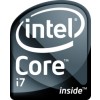- Qualcomm Launches Snapdragon 4 Gen 2 Mobile Platform
- AMD Launches Ryzen PRO 7000 Series Mobile & Desktop Platform
- Intel Launches Sleek Single-Slot Arc Pro A60 Workstation Graphics Card
- NVIDIA Announces Latest Ada Lovelace Additions: GeForce RTX 4060 Ti & RTX 4060
- Maxon Redshift With AMD Radeon GPU Rendering Support Now Available
Intel Core i7 Performance Preview

With Core i7’s launch due in just a few weeks, there’s no better time than right now to take a hard look at its performance, which is what we’re taking care of today. In addition to our usual performance comparisons with last-gen CPUs, we’re also taking an in-depth look at both QPI and HyperThreading performance, and some of our results may surprise you.
Page 12 – HyperThreading & QPI Performance
Two of the major new features on Core i7 are the Quick Path Interconnect and the return of HyperThreading. Both technologies are explained in some depth on page two of this article, so to study up, I recommend checking it out.
Our goals on this page and the next are to find out just what sort of benefit can be had with a) using a higher QPI speed and b) enabling HyperThreading. To help with that, we re-ran almost every-single one of our benchmarks again, but this time with a slightly different focus, and different configurations.
We’re using four configurations in total, but each one uses the same Extreme 965 processor. The first configuration setting is all-around stock, with Turbo and HT enabled. The second is the same setting, but with a lower QPI frequency, from 6.4GT/s (3200MHz) to 4.8GTS (2400MHz).
Our final two settings are the most important. Both run with a default QPI frequency, but the first has Turbo disabled, meaning that the CPU will run at a constant 3.20GHz, no higher or lower, while the final setting has Turbo enabled, but HyperThreading disabled. That essentially cuts down the number of threads from 8 to 4, similar to last-gen processors.
3D Renderers
Although we’ve concluded that Core i7 in general is faster than Core 2 in pretty-much every-single test we ran, the biggest increases in performance were seen with our 3D rendering applications. There, we attributed that a big reason for the huge boost was due to HyperThreading, and these next few graphs solidify that fact.

Turning HT off caused very noticeable changes… a full decrease in performance of 25%. Minor changes were seen with the Techgage Dog model, which leads us to believe that ray tracing-based tasks can take better advantage of multi-threaded processors than most anything else.


Like earlier, we once again see similar results between 3ds Max and POV-Ray. Here, we see a 29% performance boost with HT enabled. By contrast, Cinebench saw an 18.4% increase in performance. That’s far from being lackluster, but it’s not quite as impressive as the ray tracing performance.
Video Encoding & Image Manipulation
Our video-related tests showed some nice increases as well with Core i7, but nothing near as stark as with our rendering results. Still, as it appears below, HyperThreading wasn’t really the reason here. Although increases are seen, those alone don’t make up for the general speed increases we saw earlier.


While HyperThreading can be thanked for the main performance increase with rendering, video encoding is a different story. Although I’m unsure the exact reasons we see increases here, one in particular is likely SSE4.2. When we first experimented with SSE4.1 last fall with the launch of the 45nm processors, the differences were huge, so I’d expect that the general enhancements here helped even further.

Where photo manipulation is concerned, at least with Lightroom, HyperThreading makes no difference whatsoever. Enabled or disabled, the results are going to be pretty-well exactly the same, which does strike me as a little odd.
Although it’s a multi-threaded application, I don’t believe it tackles more than one photo at a time. Rather, its algorithm is designed to take advantage of multi-core processors, but with one photo at a time. I think greater increases would be seen if the application was redesigned to tackle more than one photo at a time, rather than how its current implementation works.
Support our efforts! With ad revenue at an all-time low for written websites, we're relying more than ever on reader support to help us continue putting so much effort into this type of content. You can support us by becoming a Patron, or by using our Amazon shopping affiliate links listed through our articles. Thanks for your support!





